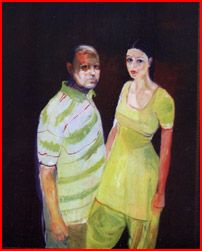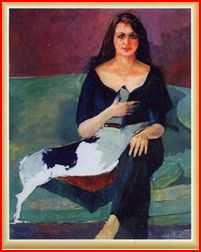True to His Muse
By Salwat Ali | Art | Arts & Culture | Published 18 years ago
An established signature and an unwavering commitment to his cause sustain Iqbal Hussain’s stature as an artist, while his aesthetic output plummets and soars by turns. Prolific production aside, Hussain’s art in the last few years has been traversing the bumpy road of hits and misses. All artists go through periods or phases when their art is more or less inspired, and while Hussain remains faithful to his muse, his workmanship level has begun to fluctuate.
 First attracting attention in the early ’80s, when his exhibition portraying garish women of the bazaar without dupattas was cancelled just hours before its opening, Hussain has covered considerable ground in the last two decades. His work has won international acclaim and is much sought after at home. Memorable paintings, like ‘Lady with Wine Glass’ and ‘Lady at Dressing Table,’ were not just true-to-life portrayals of aging courtesans in all their tacky glory, but also strong reflections of ethnic bazaar culture typical to Heera Mandi. Painting in the manner of the impressionist masters, Hussain made lavish use of paint, his brushwork was free and confident and he successfully established his own brand of drawing and painting the figure. A tired, saggy body language and sad, soulful, often vacant eyes instantly impacted and made captive many a viewer. But now, as he exhibits for the umpteenth time, one wonders if he has not said it all. The models change but the subject is still the same. Repetition could be breeding boredom, but a brief chat with the artist at his latest exhibition ‘Iqbal Hussain Vision 2007′ at Canvas proved otherwise.
First attracting attention in the early ’80s, when his exhibition portraying garish women of the bazaar without dupattas was cancelled just hours before its opening, Hussain has covered considerable ground in the last two decades. His work has won international acclaim and is much sought after at home. Memorable paintings, like ‘Lady with Wine Glass’ and ‘Lady at Dressing Table,’ were not just true-to-life portrayals of aging courtesans in all their tacky glory, but also strong reflections of ethnic bazaar culture typical to Heera Mandi. Painting in the manner of the impressionist masters, Hussain made lavish use of paint, his brushwork was free and confident and he successfully established his own brand of drawing and painting the figure. A tired, saggy body language and sad, soulful, often vacant eyes instantly impacted and made captive many a viewer. But now, as he exhibits for the umpteenth time, one wonders if he has not said it all. The models change but the subject is still the same. Repetition could be breeding boredom, but a brief chat with the artist at his latest exhibition ‘Iqbal Hussain Vision 2007′ at Canvas proved otherwise.
Hussain asserts with conviction that he is devoted to his muse and will continue to paint the women of Heera Mandi as he sees them. His Ravi landscapes give him the temporary break that he needs once in a while to indulge in change of style and tempo, but beyond that he has no intention of exploring new territory just to be trendy.
 An insider, he speaks with the confidence of one who belongs to the community and understands the consuming sadness behind the bright lights. It is this awareness that prompts him to put paint to canvas. Realising the gravity of the divide between the inhabitants of Heera Mandi and the so-called civilised society, his canvases capture the anomaly from many aspects. The withdrawn, blank faces, brazenly inviting but with unreal postures, tired morning-after looks, the mosque in the distance indicating the role of religion in the lives of the women, and the tacky décor of the boudoirs, all articulate a culture within a culture. But it is the figures spread across the beds, young girls with pregnant bellies or splayed legs tied with chains that voice the real helplessness inherent in the lives of these women. Hussain does not adopt a moralising tone; rather, he paints it all very nonchalantly, letting the viewer think for himself. His models — pretty young girls, aging jezebels or old matrons — seldom smile, are often lost in reverie; their anaemic faces appear nervous, uneasy and anxious, sometimes even grim. Hussain merely paints their real self. Viewers can draw their own conclusions.
An insider, he speaks with the confidence of one who belongs to the community and understands the consuming sadness behind the bright lights. It is this awareness that prompts him to put paint to canvas. Realising the gravity of the divide between the inhabitants of Heera Mandi and the so-called civilised society, his canvases capture the anomaly from many aspects. The withdrawn, blank faces, brazenly inviting but with unreal postures, tired morning-after looks, the mosque in the distance indicating the role of religion in the lives of the women, and the tacky décor of the boudoirs, all articulate a culture within a culture. But it is the figures spread across the beds, young girls with pregnant bellies or splayed legs tied with chains that voice the real helplessness inherent in the lives of these women. Hussain does not adopt a moralising tone; rather, he paints it all very nonchalantly, letting the viewer think for himself. His models — pretty young girls, aging jezebels or old matrons — seldom smile, are often lost in reverie; their anaemic faces appear nervous, uneasy and anxious, sometimes even grim. Hussain merely paints their real self. Viewers can draw their own conclusions.
Taking solace in each other’s company, his protagonists seem to have built their own fraternity within the walled city. For many viewers, Hussain’s art is a window into the reality of this world. His work is synonymous with this subject. As an artist he has taken on the onerous task of keeping an issue alive, even at the cost of painting through his dull moments. The strain is evident in his brushwork as it swings from the delightful to the slapdash. The Canvas show was spotted with some excellent large portrait paintings and many smaller, casually worked figurative studies. For Hussain, the show goes on no matter what.


